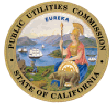 California Public Utilities Commission
California Public Utilities Commission
505 Van Ness Ave., San Francisco
________________________________________________________________________
FOR IMMEDIATE RELEASE PRESS RELEASE
Contact: Terrie Prosper, 415.703.1366, news@cpuc.ca.gov Docket #: A.07-06-018
CPUC APPROVES AREA CODE OVERLAY INSTEAD
OF A SPLIT FOR THE 760 AREA CODE
SAN FRANCISCO, October 16, 2008 - The California Public Utilities Commission (CPUC) today granted a petition to modify its decision to split the 760 area code and instead ordered an area code overlay of 442 to the same geographic region as the 760 area code.
On April 24, 2008, the CPUC adopted a geographic split to address the projected shortage of available telephone numbers in the 760 area code. On August 15, 2008, Assemblyman Martin Garrick and the Chambers of Commerce of Carlsbad, Encinitas, Escondido, San Marcos, Oceanside, and Vista filed a Petition for Modification asking the CPUC to modify its decision and adopt an area code overlay rather than the split that had been adopted.
The CPUC subsequently held Public Participation Hearings in Victorville and Carlsbad to take public comment on the Petition for Modification. At the hearings the overarching theme was that changing the area code would impose substantial costs on businesses for advertising, documents, products, as well as lost customers when they are unable to reach businesses, and that residential customers would suffer lost contacts from friends and family when the 760 area code would no longer be effective for their telephone numbers.
Written responses in support of the Petition for Modification were submitted by Verizon California, Inc., AT&T California, Verizon Wireless, Telscape Communications, Inc., Sprint Nextel Corporation, and Cox Communications. The responses reiterated the major themes of the petition; namely, that an overlay is preferred because it would be less expensive for customers to implement and would allow all to retain their existing telephone number and area code.
The CPUC considered the volume and substance of all comments received, both in favor of and opposed to a split, and determined that it should grant the Petition for Modification and adopt a geographic overlay, which will allow all customers to retain their existing telephone numbers. The overlay will require all customers to adopt the 10-digit dialing protocol.
"In making the initial decision to split the 760 area code, the CPUC listened to the residents and elected officials who provided comment on the issue, most of whom preferred a split," said CPUC President Michael R. Peevey. "Only after the initial decision was issued did we hear from more businesses and residents. It now appears that more people prefer an overlay and feel it would be less burdensome. Based on comments and weighing the cost to implement a geographic split against the burden of 10-digit dialing for an overlay, the CPUC determined that an overlay is warranted."
"As the lone dissenter to the initial decision, I am gratified that my fellow Commissioners have supported the modification," said Commissioner Timothy Alan Simon. "This decision correctly recognizes that, with modern technologies and human behavioral trends, overlays are the most logical and reasonable response to area code exhaust."
The CPUC set the following implementation plan:
DATE |
EVENT |
Saturday, May 2, 2009 |
Permissive Dialing begins |
Saturday, October 24, 2009 |
Mandatory Dialing begins |
Saturday, November 21, 2009 |
New 442 area code becomes effective |
Beginning on the effective date of the 442 area code, all customers in the 760 area code will need to dial the area code for all calls. This includes local calls, even between houses across the street from each other.
The CPUC ordered telephone companies with numbering resources in the 760 area code to implement a public education program to assist customers in adopting the new 10-digit dialing protocol.
The proposal voted on by the CPUC is available at http://docs.cpuc.ca.gov/word_pdf/AGENDA_DECISION/92263.doc.
For more information on the CPUC, please visit www.cpuc.ca.gov.
###
